 |
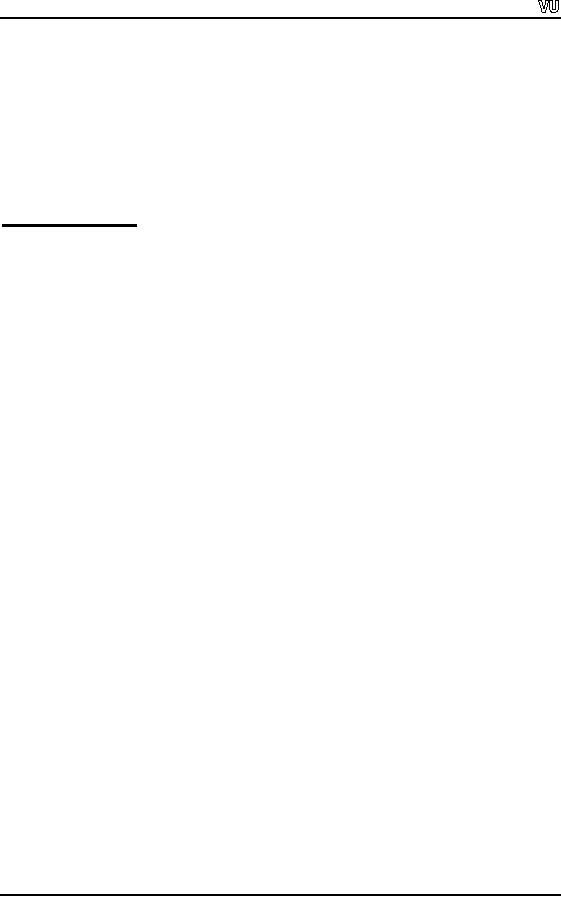
CS201
Introduction to Programming
Lecture
Handout
Introduction
to Programming
Lecture
No. 9
Reading
Material
Deitel
& Deitel C++ How to
Program
chapter
2
3.1,
3.2, 3.3, 3.4,
3.5,
3.6
Summary
Introduction
o
Functions
o
Structure
of a Function
o
Declaration
and Definition of a Function
o
Sample
Program 1
o
Sample
Program 2
o
Sample
Program 3
o
Summary
o
Tips
o
Introduction
Now
our toolkit is almost complete. The
basic constructs of programming
are sequence,
decision
making and loops. You
have learnt all these
techniques. Now we can
write
almost
all kinds of programs. There
are more techniques to further refine the
programs.
One of
the major programming
constructs is Functions. C is a function-oriented
language.
Every
program is written in different
functions.
In our
daily life, we divide our
tasks into sub tasks.
Consider the making of a
laboratory
stool.
Page
79

CS201
Introduction to Programming
It has a
seat and three legs.
Now we need to make a seat
and three legs out of
wood. The
major
task is to make a stool. Sub
tasks are, make a seat
and then fabricate three
legs. The
legs
should be identical. We can fashion
one leg and then re-using
this prototype, we
have to
build two more identical
legs. The last task is to
assemble all these to make
a
stool. We
have a slightly difficult
task and have broken
down it into simpler pieces.
This
is the
concept of functional design or
top-down designing. In top
design, we look at
the
problem
from top i.e. identification of
the problem. What we have to
solve? Then refine it
and
divide it into smaller pieces. We refine
it again and divide it into
smaller pieces. We
keep on
doing it as long as we get easily
manageable task. Let's
consider an example like
home
construction. From the top
level, we have to construct a
home. Then we say that
we
need
design of the home according
to which the building will
be constructed. We need to
construct
rooms. How can we construct a
room? We need bricks,
cement, doors,
windows
etc. Procurement of all of
these things is tasks. Once we
come down to the
level
where a
task is easily manageable and
doable, we stop doing further refinement.
When
we break
up a task into smaller sub
tasks, we stop at a reasonable
level. Top-down
designing
mechanism is based on the principle of
'divide and conquer' i.e. we
divide a big
task
into smaller tasks and then
accomplish them.
Let's
have a look at a simple example to
understand the process of
dividing big task
into
simple
ones. Suppose we want to
know how many students
are currently logged in
the
LMS
(Learning Management System) of VU. This
task will be handed over to
the
network
administrator to find out the
number of students currently logged in
LMS of the
university.
The network administrator will
check the network activity
or get this
information
from the database and
get the list of students
currently logged in.
The
number of
students is counted from
that list and the
result is given back to us.
What has
happened
in this whole process? There
was a simple request to find
the number of
students
currently logged in LMS. This
request is delegated to the
network administrator.
The
network administrator performs this task
and we get the result. In
the mean time, we
can do
some other task as we are
not interested in the names
or list of students. We
only
want
the number of students. This
technique is known as parallel
processing. In terms of
programming,
network administrator has performed a
function i.e. calculation of the
number of
students. During this process,
the network administrator also
gets the list of
students
which is hidden from us. So
the information hiding is
also a part of the
function.
Some
information is given to the network
administrator (i.e. the request to
calculate the
number of
students currently logged in the
LMS) while some information
is provided
back to
us (i.e. the number of
students).
Page
80
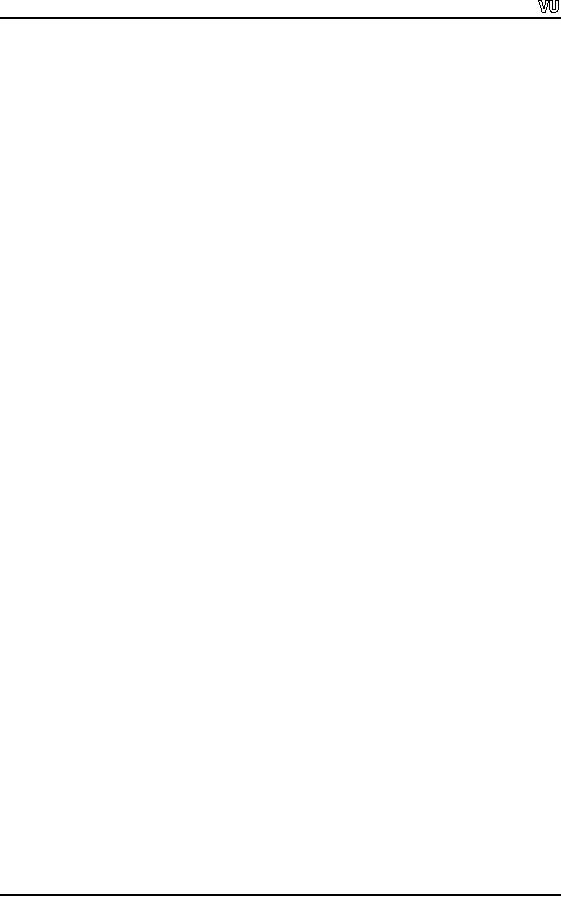
CS201
Introduction to Programming
Functions
The
functions are like subtasks.
They receive some
information, do some process
and
provide a
result. Functions are
invoked through a calling program.
Calling program does
not
need to know what the
function is doing and how it is
performing its task. There
is a
specific
function-calling methodology. The calling
program calls a function by giving
it
some
information and receives the
result.
We have a
main ( ) in every C program.
`main ( )' is also a function. When we
write a
function,
it must start with a name,
parentheses, and surrounding
braces just like
with
main ( ).
Functions are very important
in code reusing.
There
are two categories of
functions:
1.
Functions that return a
value
2.
Functions that do not return
a value
Suppose,
we have a function that
calculates the square of an
integer such that
function
will
return the square of the
integer. Similarly we may
have a function which
displays
some
information on the screen so
this function is not
supposed to return any value
to the
calling
program.
Structure of
a Function
The
declaration syntax of a function is as
follows:
return-value-type
function-name( argument-list )
{
declarations
and statements
}
The
first line is the function
header and the declaration
and statement part is the
body of
the
function.
return-value_type:
Function
may or may not return a
value. If a function returns a
value, that must be of a
valid
data type. This can
only be one data type that
means if a function returns an
int data
type than
it can only return int
and not char or float.
Return type may be int,
float, char or
any
other valid data type.
How can we return some
value from a function? The
keyword
is return
which is
used to return some value
from the function. It does
two things, returns
some
value to the calling program
and also exits from
the function. We can only
return a
value (a
variable or an expression which evaluates
to some value) from a function.
The
data type
of the returning variable should match return_value_type
data
type.
Page
81
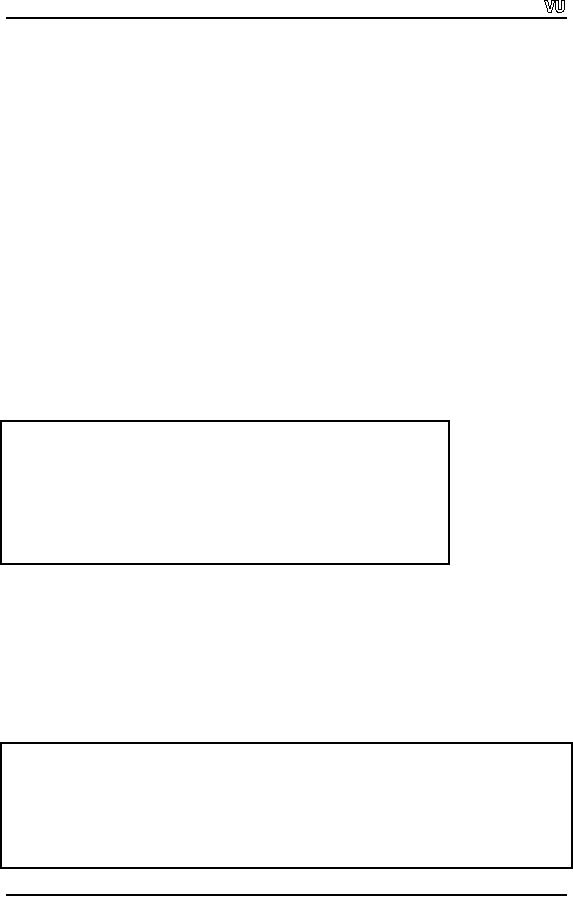
CS201
Introduction to Programming
There
may be some functions which do
not return any value.
For such functions,
the
return_value_type
is
void. `void'
is a keyword of `C' language.
The default
return_value_type
is of
int
data type
i.e. if we do not mention any return_value_type
with
a
function, it will return an
int
value.
Function-name:
The
same rules of variable naming conventions
are applied to functions name.
Function
name
should be self-explanatory like square,
squareRoot, circleArea
etc.
argument-list:
Argument
list contains the
information which we pass to
the function. Some
function
does
not need any information to
perform the task. In this
case, the argument list
for such
functions
will be empty. Arguments to a function
are of valid data type like
int number,
double
radius etc.
Declarations
and Statements:
This is
the body of the function. It
consists of declarations and
statements. The task of
the
function
is performed in the body of the
function.
Example:
//This
function calculates the
square of a number and
returns it.
int
square(int number)
{
int
result = 0;
result =
number * number;
return
result;
}
Calling
Mechanism:
How a
program can use a function? It is very
simple. The calling program
just needs to
write
the function name and
provide its arguments (without
data types). It is important
to
note
that while calling a
function, we don't write the
return value data type or
the data
types of
arguments.
Example:
//This
program calculates the
square of a given number
#include
<iostream.h>
main()
{
int
number, result;
Page
82
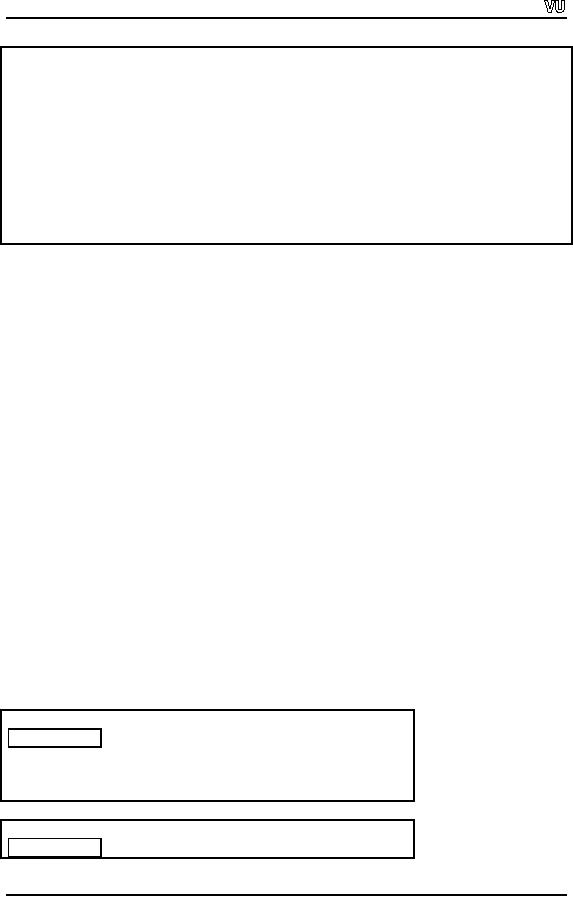
CS201
Introduction to Programming
result =
0;
number =
0;
// Getting
the input from the
user
cout
<< " Please enter the
number to calculate the
square ";
cin
>> number;
//
Calling the function
square(int number)
result =
square(number);
cout
<< " The square of " <<
number << " is " << result;
}
Declaration
and Definition of a
Function
Declaration
and definition are two
different things. Declaration is the prototype of
the
function,
that includes the return
type, name and argument
list to the function
and
definition
is the actual function code.
Declaration of a function is also known
as signature
of a
function.
As we
declare a variable like int
x; before
using it in our program,
similarly we need to
declare
function before using it.
Declaration and definition of a function
can be combined
together
if we write the complete function
before the calling functions.
Then we don't
need to
declare it explicitly. If we have
written all of our functions in a
different file and
we call
these functions from main(
) which is
written in a different file. In
this case, the
main(
) will
not be compiled unless it
knows about the functions
declaration. Therefore
we write
the declaration of functions before
the main(
) function.
Function declaration is
a one
line statement in which we
write the return type,
name of the function and
the data
type of
arguments. Name of the
arguments is not necessary.
The definition of the
function
contains
the complete code of the
function. It
starts with the declaration
statement with
the
addition that in definition, we do
write the names of the
arguments. After this, we
write an
opening brace and then
all the statements, followed
by a closing brace.
Example:
If the
function square is defined in a separate
file or after the calling
function, then we
need to
declare it:
Declaration:
int
square ( int );
Definition:
Page
83
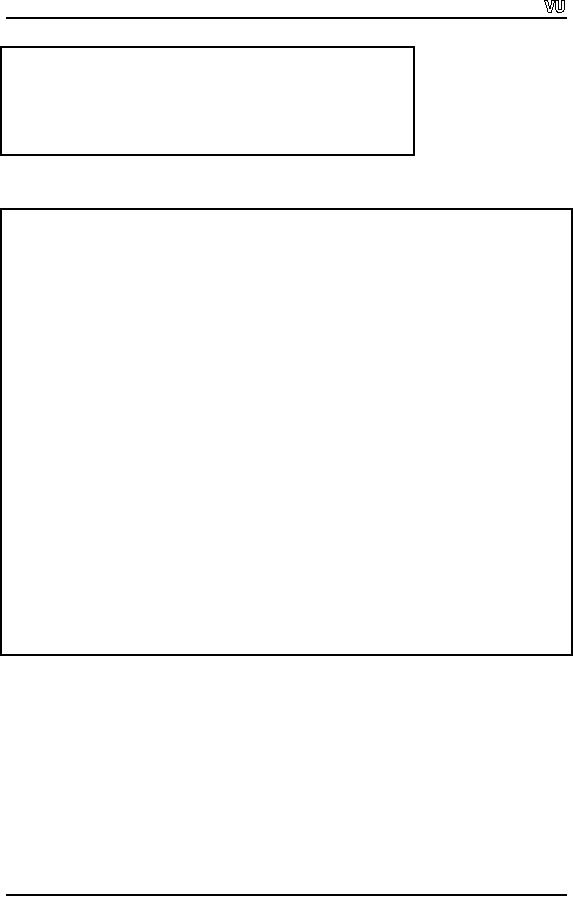
CS201
Introduction to Programming
int
square ( int number)
{
return
(number * number ) ;
}
Here is
the complete code of the
program:
//This
program calculates the
square of a given number
#include
<iostream.h>
// Function
declarations.
int
square(int);
main()
{
int
number, result;
result =
0;
number =
0;
cout
<< " Please enter the
number to calculate the
square ";
cin
>> number;
//
Calling the function
square(int number)
result =
square(number);
cout
<< " The square of " <<
number << " is " << result;
}
//
function to calculate the
square of a number
int
square ( int number)
{
return
(number * number ) ;
}
A
function in a calling program
can take place as a
stand-alone statement, on right-
hand
side of a
statement. This can be a
part of an assignment
expression.
Considering
the above example, here are
some more ways of function
calling mechanism.
result =
10 + square (5);
or
result =
square (number + 10);
or
result =
square (number) + square (number + 1) +
square (3 * number);
or
Page
84
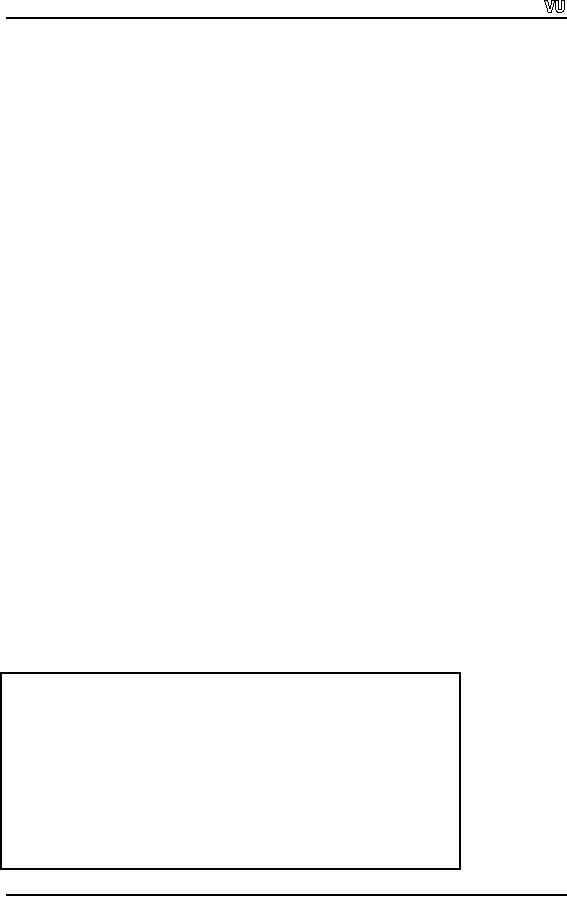
CS201
Introduction to Programming
cout
<< " The square of " <<
number << " is " << square
(number);
In the
above statements, we see
that functions are used in
assignment statements. In a
statement
result =
square(5); The
square(5)
function
is called and the value
which is
returned
from that function (i.e. the
value returned within the
function using the return
keyword)
is assigned to the variable result. In this
case, the square(5)
will
return 25,
which
will be assigned to variable result. There
may be functions which do not
return any
value.
These functions can't be used in
assignment statements. These functions
are
written
as stand-alone statements.
Sample
Program 1
C is called
function-oriented language. It is a very
small language but there
are lots of
functions in
it. Function can be on a single line, a
page or as complex as we
want.
Problem
statement:
Calculate
the integer power of some
number (xn).
Solution:
We want
to get the power of some
number. There is no operator
for power function in
C.
We need
to write a function to calculate
the power of x to n (i.e. xn). How can we
calculate
the power of some number? To
get the power of some
number x to n, we need
to
multiply x with x up to n times. Now
what will be the input
(arguments) to the
function? A
number and power, as number
can be a real number so we
have to declare
number as
a double date type and the
power is an integer value so we
will declare the
power as
an integer. The power is an
integer value so we will declare
power as an integer.
The
result will also be a real
number so the return value
type will be of double data
type.
The
function name should be descriptive, we
can name this function as
raiseToPow.
The
declaration
of the function is:
double
raiseToPow ( double x, int power )
;
To
calculate the power of x
up to
power
times, we
need a loop which will be
executed
power
times.
The definition of function
is:
//
function to calculate the
power of some number
double
raiseToPow ( double x , int power
)
{
double
result ;
int i
;
result =
1.0 ;
for ( i =
1 ; i <= power ; i ++ )
{
result *=
x ; // same as result = result *
x
Page
85
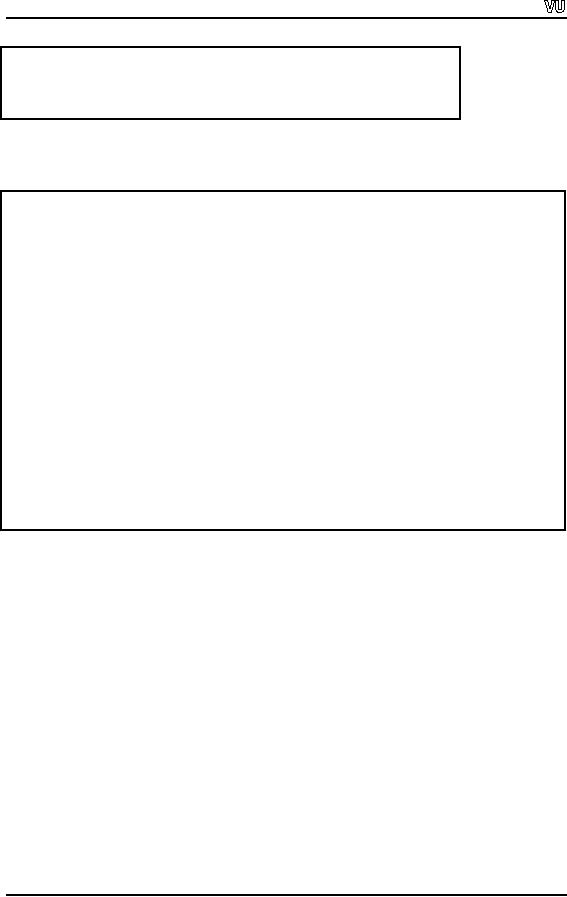
CS201
Introduction to Programming
}
return (
result ) ;
}
Here is
the program which is calling
the above function.
// This
program is calling a function
raiseToPow.
#include
<iostream.h>
//Function
declaration
double
raiseToPow ( double , int )
main (
)
{
double x
;
int i
;
cout
<< " Please enter the
number " ;
cin
>> x ;
cout
<< " Please enter the
integer power that you
want this number raised to "
;
cin
>> i ;
cout
<< x << " raise to power " << i
<< " is equal to " << raiseToPow ( x , i )
;
}
Now we
have to consider what will
happen to the values of
arguments that are passed
to
the
function? As in the above program, we
are passing x
and
i
to
the raiseToPow
function.
Actually nothing is happening to the
values of x
and
i. These
values are
unchanged.
A copy of values x and i are
passed to the function and
the values in the
calling
program are unchanged. Such
function calls are known as
'call by value'. There
is
another
way to call a function in
which the function can
change the values of
variables
that
are passed as arguments, of
calling program. Such
function call is known as
call by
reference.
Sample
Program 2
Problem
statement:
Calculate
the area of a ring.
Solution:
Page
86
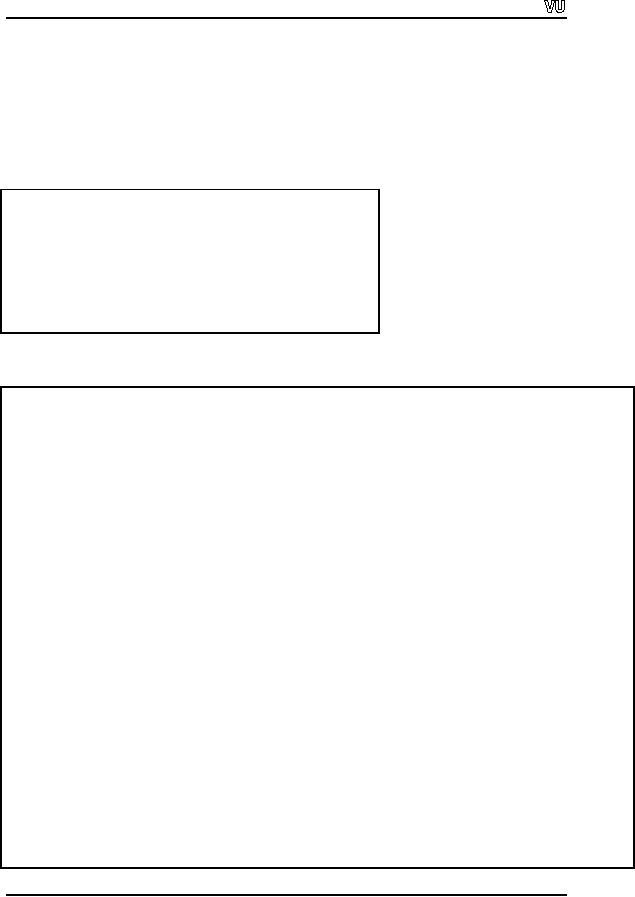
CS201
Introduction to Programming
We know
that a ring consists of a
small circle and a big
circle. To calculate the
area of a
ring, we
have to subtract the area of
small circle from the
area of big circle. Area of
any
circle is
calculated as Pi * r2. We
write a function to calculate
the area of a circle and
use
this
function to calculate the
area of small circle and
big circle.
Following
is the code of the function
circleArea:
//
Definition of the circleArea
function.
double
circleArea ( double radius
)
{
// the
value of Pi = 3.1415926
return (
3.1415926 * radius * radius )
;
}
Here is
the complete code of the
calling program.
// This
program calculates the area
of a ring
#include
<iostream.h>
//
function declaration.
double
circleArea ( double);
void
main ( )
{
double
rad1 ;
double
rad2 ;
double
ringArea ;
cout
<< " Please enter the
outer radius value: " ;
cin
>> rad1 ;
cout
<< " Please enter the
radius of the inner circle: "
;
cin
>> rad2 ;
ringArea
= circleArea ( rad1 ) circleArea
(rad2 ) ;
cout<<
" Area of the ring having inner raduis "
<< rad2 << " and the
outer radius " <<
rad1
<< " is " << ringArea ;
}
double
circleArea ( double radius
)
{
// the
value of Pi = 3.1415926
return (
3.1415926 * radius * radius )
;
Page
87
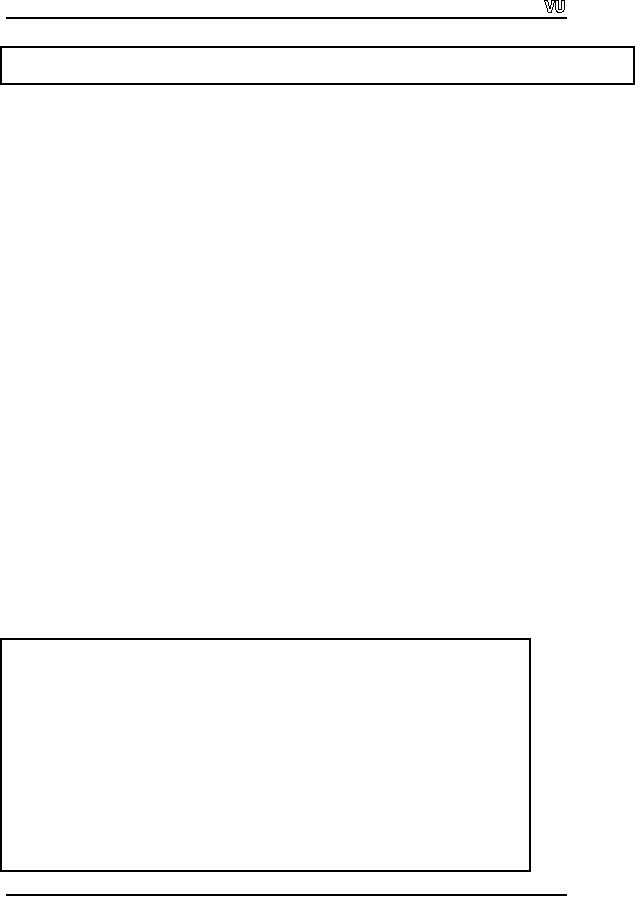
CS201
Introduction to Programming
}
Sample
Program 3
There
are some other kinds of
functions which are used to
test some condition.
Such
functions
return true
or
false. These
functions are very important
and used a lot in
programming. In C
condition statements, the
value zero (0) is considered as
false and any
value
other than zero is
considered as true. So the
return type of such functions is int.
We
usually
return 1 when we want the
function to return true and
return 0 when we want
the
function
to return 0. Here is a sample program to
elaborate this.
Problem
statement:
Write a
function which tests that a
given number is even or not? It
should return true if
the
number is even, otherwise return
false.
Solution:
We
already know the method of
deciding whether a number is even or not.
The name of
the
function is isEven. Its
return type will be int. It will
take an int
as an
argument. So the
declaration
of the function should be as
below;
int
isEven ( int ) ;
We can
also use a function in the
conditional statements
like:
if ( isEven (
number ) )
If the
number is even, the function
will return none zero value
(i.e. usually 1) and the if
statement
will be
evaluated as true. However, if
the number is odd, the
function will
return a
zero value and the
if
statement is
evaluated as false.
Here is a complete
program.
// This
program is calling a function to
test the given number is
even or not
#include
<iostream.h>
//
function declaration.
int
isEven(int);
void
main ( )
{
int
number;
cout
<< " Please enter the number: "
;
cin
>> number ;
Page
88
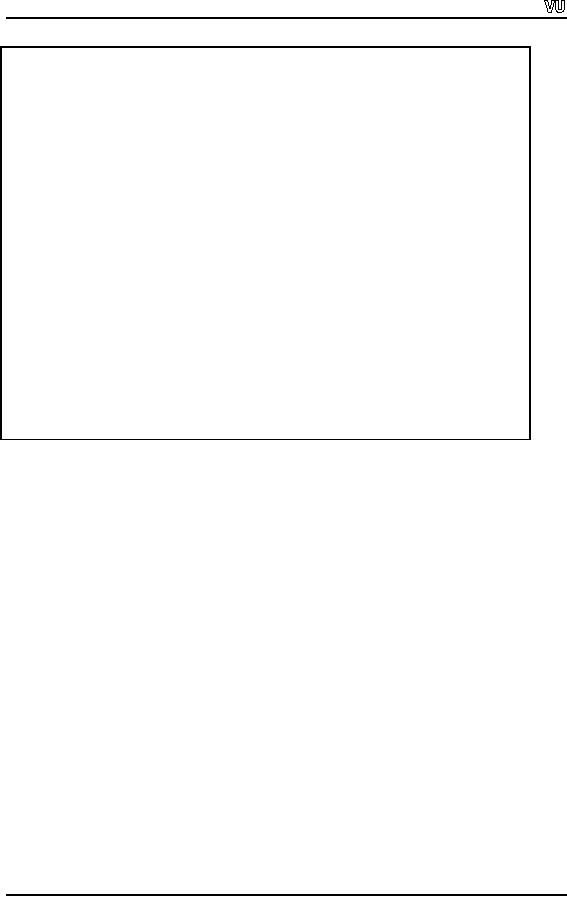
CS201
Introduction to Programming
if ( isEven (
number ) )
{
cout
<< " The number entered is
even " << endl;
}
else
{
cout
<< " The number entered is
odd " << endl;
}
}
int
isEven ( int number )
{
if ( 2 * (
number / 2 ) == number )
{
return
1;
}
else
{
return
0;
}
}
Summary
Functions
are very good tools for
code reuse. We have seen in
the above example that
the
area of
two circles has been
calculated without rewriting
the code. This means
that the
code
has been reused. We can
reuse the circleArea
function
to find the area of any
circle.
A
function performs a specific task.
Functions also provide encapsulation.
The calling
program
does not know how
the function is performing
its task. So we can build
up
modular
form from small building
blocks and build up more and
more complex
programs.
If we are
going to use a function in our program
and the definition of the
function is after
the
calling program. The
calling program needs to
know how to call the
function, what
the
arguments are and what it
will return. So its
declaration must occur before
usage. If
we do not
declare a function before
using, the compiler will
give an error. If we define a
function
before the calling program,
then we do not need a
separate declaration.
The
function
declaration is also known as
function prototype or function signature.
Whenever,
we need
to build something, first of all we
build a prototype of that thing
and then later
on we
build it. Similarly the
function declaration is used as a
prototype. We are following
the top-
down methodology. We break the program
into smaller modules and just
declare
the
functions and later on we can define
these.
Page
89
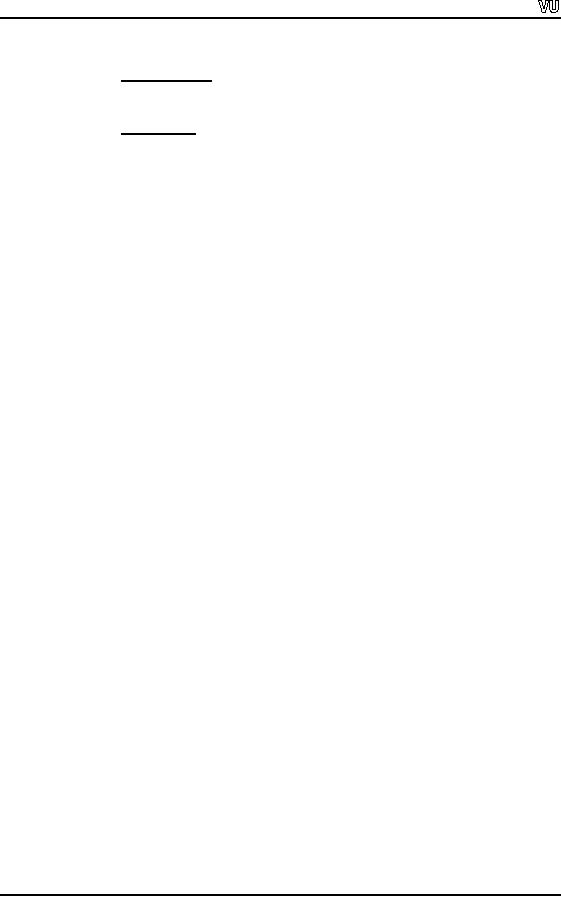
CS201
Introduction to Programming
Exercise:
1. Modify
the raise to
power function
so that it can handle
negative power of x,
zero
and
positive power of x.
2. Modify
the area
of ring function
put in error checking mechanism.
Tips
·
We used
functions for breaking complex problems
into smaller pieces,
which is
a top-down structured
approach.
·
Each
function should be a small module,
self-contained. It should solve a
well
defined problem.
·
Variable
names and function names
should be self- explanatory.
·
Always
comment the code.
Page
90
Table of Contents:
- What is programming
- System Software, Application Software, C language
- C language: Variables, Data Types, Arithmetic Operators, Precedence of Operators
- C++: Examples of Expressions, Use of Operators
- Flow Charting, if/else structure, Logical Operators
- Repetition Structure (Loop), Overflow Condition, Infinite Loop, Properties of While loop, Flow Chart
- Do-While Statement, for Statement, Increment/decrement Operators
- Switch Statement, Break Statement, Continue Statement, Rules for structured Programming/Flow Charting
- Functions in C: Structure of a Function, Declaration and Definition of a Function
- Header Files, Scope of Identifiers, Functions, Call by Value, Call by Reference
- Arrays: Initialization of Arrays, Copying Arrays, Linear Search
- Character Arrays: Arrays Comparisonm, Sorting Arrays Searching arrays, Functions arrays, Multidimensional Arrays
- Array Manipulation, Real World Problem and Design Recipe
- Pointers: Declaration of Pointers, Bubble Sort Example, Pointers and Call By Reference
- Introduction, Relationship between Pointers and Arrays, Pointer Expressions and Arithmetic, Pointers Comparison, Pointer, String and Arrays
- Multi-dimensional Arrays, Pointers to Pointers, Command-line Arguments
- String Handling, String Manipulation Functions, Character Handling Functions, String Conversion Functions
- Files: Text File Handling, Output File Handling
- Sequential Access Files, Random Access Files, Setting the Position in a File, seekg() and tellg() Functions
- Structures, Declaration of a Structure, Initializing Structures, Functions and structures, Arrays of structures, sizeof operator
- Bit Manipulation Operators, AND Operator, OR Operator, Exclusive OR Operator, NOT Operator Bit Flags Masking Unsigned Integers
- Bitwise Manipulation and Assignment Operator, Programming Constructs
- Pre-processor, include directive, define directive, Other Preprocessor Directives, Macros
- Dynamic Memory Allocation, calloc, malloc, realloc Function, Dangling Pointers
- History of C/C++, Structured Programming, Default Function Arguments
- Classes and Objects, Structure of a class, Constructor
- Classes And Objects, Types of Constructors, Utility Functions, Destructors
- Memory Allocation in C++, Operator and Classes, Structures, Function in C++,
- Declaration of Friend Functions, Friend Classes
- Difference Between References and Pointers, Dangling References
- Operator Overloading, Non-member Operator Functions
- Overloading Minus Operator, Operators with Date Class, Unary Operators
- Assignment Operator, Self Assignmentm, Pointer, Conversions
- Dynamic Arrays of Objects, Overloading new and delete Operators
- Source and Destination of streams, Formatted Input and Output, Buffered Input/Output
- Stream Manipulations, Manipulators, Non Parameterized Manipulators, Formatting Manipulation
- Overloading Insertion and Extraction Operators
- User Defined Manipulator, Static keyword, Static Objects
- Pointers, References, Call by Value, Call by Reference, Dynamic Memory Allocation
- Advantages of Objects as Class Members, Structures as Class Members
- Overloading Template Functions, Template Functions and Objects
- Class Templates and Nontype Parameters, Templates and Static Members
- Matrices, Design Recipe, Problem Analysis, Design Issues and Class Interface
- Matrix Constructor, Matrix Class, Utility Functions of Matrix, Input, Transpose Function
- Operator Functions: Assignment, Addition, Plus-equal, Overloaded Plus, Minus, Multiplication, Insertion and Extraction